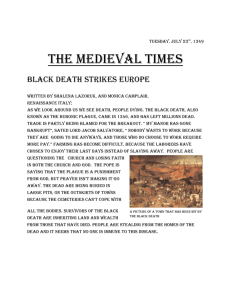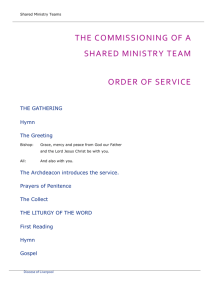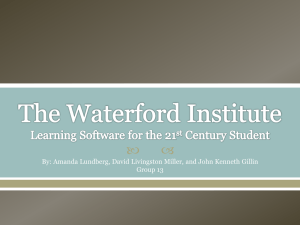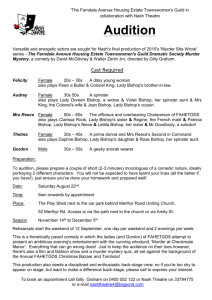Homily by Michael Olden - Diocese of Waterford & Lismore
advertisement
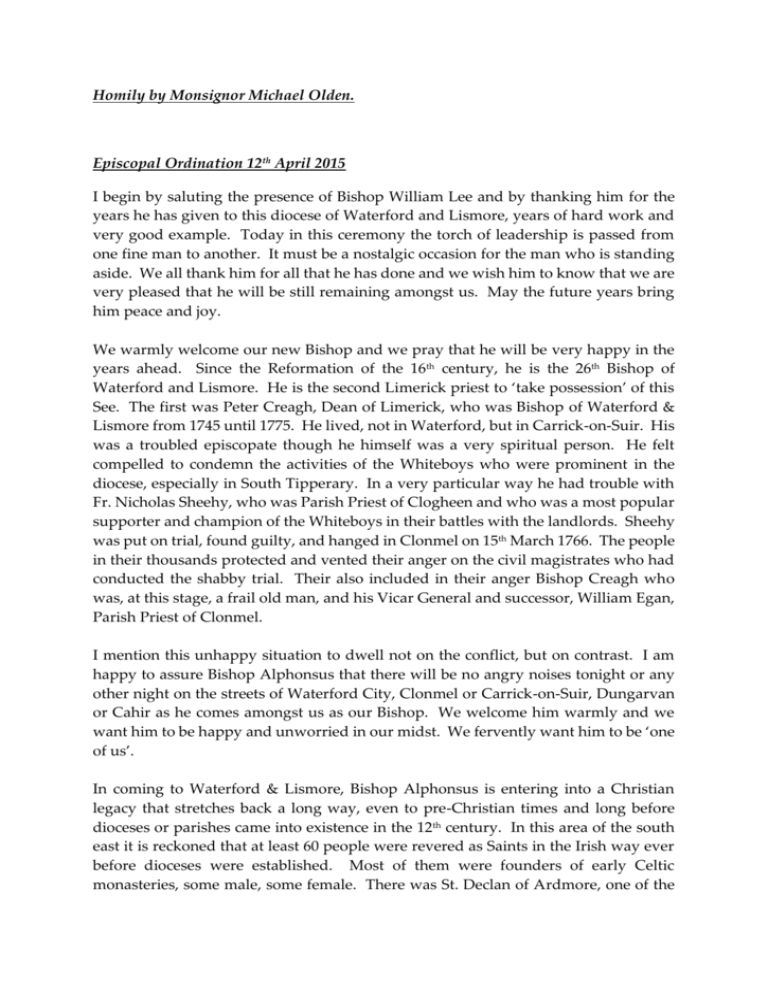
Homily by Monsignor Michael Olden. Episcopal Ordination 12th April 2015 I begin by saluting the presence of Bishop William Lee and by thanking him for the years he has given to this diocese of Waterford and Lismore, years of hard work and very good example. Today in this ceremony the torch of leadership is passed from one fine man to another. It must be a nostalgic occasion for the man who is standing aside. We all thank him for all that he has done and we wish him to know that we are very pleased that he will be still remaining amongst us. May the future years bring him peace and joy. We warmly welcome our new Bishop and we pray that he will be very happy in the years ahead. Since the Reformation of the 16th century, he is the 26th Bishop of Waterford and Lismore. He is the second Limerick priest to ‘take possession’ of this See. The first was Peter Creagh, Dean of Limerick, who was Bishop of Waterford & Lismore from 1745 until 1775. He lived, not in Waterford, but in Carrick-on-Suir. His was a troubled episcopate though he himself was a very spiritual person. He felt compelled to condemn the activities of the Whiteboys who were prominent in the diocese, especially in South Tipperary. In a very particular way he had trouble with Fr. Nicholas Sheehy, who was Parish Priest of Clogheen and who was a most popular supporter and champion of the Whiteboys in their battles with the landlords. Sheehy was put on trial, found guilty, and hanged in Clonmel on 15th March 1766. The people in their thousands protected and vented their anger on the civil magistrates who had conducted the shabby trial. Their also included in their anger Bishop Creagh who was, at this stage, a frail old man, and his Vicar General and successor, William Egan, Parish Priest of Clonmel. I mention this unhappy situation to dwell not on the conflict, but on contrast. I am happy to assure Bishop Alphonsus that there will be no angry noises tonight or any other night on the streets of Waterford City, Clonmel or Carrick-on-Suir, Dungarvan or Cahir as he comes amongst us as our Bishop. We welcome him warmly and we want him to be happy and unworried in our midst. We fervently want him to be ‘one of us’. In coming to Waterford & Lismore, Bishop Alphonsus is entering into a Christian legacy that stretches back a long way, even to pre-Christian times and long before dioceses or parishes came into existence in the 12th century. In this area of the south east it is reckoned that at least 60 people were revered as Saints in the Irish way ever before dioceses were established. Most of them were founders of early Celtic monasteries, some male, some female. There was St. Declan of Ardmore, one of the four saints of Ireland reliably considered to be before St. Patrick’s time. There was St. Carthage or Mochuda of Lismore, a Kerryman, who began the renowned monastic and university centre of Lismore in the 7th century. The Vikings, who established their port and eventually their settlement at Waterford and who become Christianised, took as their patron Saint Odhran or Otteran of Iona. To this day, the great cemetery on that historic Scottish island is named St. Oran’s cemetery. The Vikings knew Iona well as they had hugged its coastline many times on their way to Ireland to other places. Declan, Carthage and Otteran are the three Patron Saints of the Diocese. The diocese of Waterford and the diocese of Lismore had an uneasy relationship with each other between 1200 and 1363. Waterford was small but growing in population and power. Lismore was very large and ancient and Gaelic. There were saints and some hefty sinners on both sides of the divide. It has to be said that most of the blame lay with the Bishops and Clergy and people of the Waterford diocese. We read of many raids on the Cathedral of Lismore. At various times Bishops of Lismore were attacked and taken prisoner. But it was not all one-sided. A bishop of Waterford who had the dangerous name of David the Welshman was killed by members of the O Faolain family in 1209. The O Faolains were strong supporters of the Bishop and diocese of Lismore. Negotiations, strongly encouraged by Rome, dragged on for nearly 200 years. Eventually the two dioceses were united in 1363. Our new Bishop has come to this Cathedral of the Most Holy Trinity to receive the Sacrament which will equip him for the work which lies ahead. This Cathedral is the oldest post-Reformation Catholic Cathedral in Ireland. But, even so, it is still rather young. Our original Cathedral stood where Waterford’s first diocesan Bishop, Malchus, established it more than a thousand years ago. It stood on the hill about half a mile from here, where the Church of Ireland Cathedral now stands. At the time of the Reformation in the 1530’s the Catholics of Waterford were ejected from it. Since then they only succeeded in repossessing it on two occasions: one for only about a month when news reached Waterford that Queen Elizabeth I had died in 1603. The second repossession took place in 1642 and lasted about eight years. This was the time of the Confederation of Kilkenny. It ended when General Ireton, son in law of Oliver Cromwell, captured Waterford in 1650. We read that the Cathedral was packed by rejoicing Catholics every day during those heady years. It was in that Cathedral that the famous Nuncio, Gian Battista Rinuccinin, presided over synods and ceremonies. It was there that he consecrated, not one, but seven new Bishop’s on 19th March 1648. And it was in Waterford that he received news from Italy that this mother had died. Together with many Bishop’s, he celebrated a requiem Mass for her. From 1650 till 1793 there was no Catholic Cathedral in this Diocese. Times began to improve as the 18th century came to an end and took the Penal Laws away with it. This Cathedral in which Bishop Alphonsus is being ordained was built in 1793. Many changes, some quite drastic, have taken place in their building over the years. But it has always housed its High Altar and its Chair or Cathedra for its Bishop. The most significant work and the greatest act of leadership which the New Bishop will perform in the years ahead will take place at the Altar when he celebrates Eucharist. Sure, he will preside and perhaps deliver very significant statements from his chair; sure, the Cathedral gets its very name from the Cathedra or Chair which is specially assigned to the Bishop. But it is the Eucharist which takes precedence over everything else. The most significant work which our Bishop will have to do and the greatest challenge he will have to meet is to ensure that the Eucharist will be celebrated throughout every part of his diocese. From the Bishop and the Altar and Eucharist of this Cathedral will go forth the bonding message of Jesus Christ to his followers in all the parishes and churches of the diocese. He will be the principal Minister of the Eucharist and it will fall to him to encourage us Priests and the ‘People of God’ to deepen our faith in Jesus Christ and to cherish our Eucharist as the nourishment and the bond of unity we so deeply need on our pilgrim journey and in our pilgrim work. On this blessed day in this historic place let us tell him that what we will be seeking from him in charity will be gentle prayerful leadership rather than hectic management. We will welcome from his repetitious (yes, repetitious) and gentle reminders as to how we should seriously follow Jesus Christ, and how we should, with conviction and with deep respect, encourage other people, perhaps people in our own families, to find faith in a personal God who is loving and forgiving and understanding towards all who turn to him. In conclusion, I would ask him not to be a man of too much worry. It should always be a consoling reassurance to him that he has been carefully chosen for his responsibility by serious and knowledgeable people who have advised Pope Francis that he has the qualities, the virtues, the goodness and, very importantly, the imagination which are needed in all dioceses at this time. He will have the goodwill and cooperation of Priests and People. As in the way of all flesh, we may sometimes let him down. In advance we ask for this forgiveness. May we find in him the forgiveness and understanding which the apostles found in Jesus when they were a disappointment to him. On this day, Divine Mercy Sunday, a relationship is born between Bishop Alphonsus and the people of this diocese, a diocese with a varied and sometimes colourful history. May every home and heart in Waterford & Lismore, be encouraged by that relationship. May all of us, Bishops, Priests, People, work seriously and happily together as member of the Pobal De. Amen. Michael Olden.

